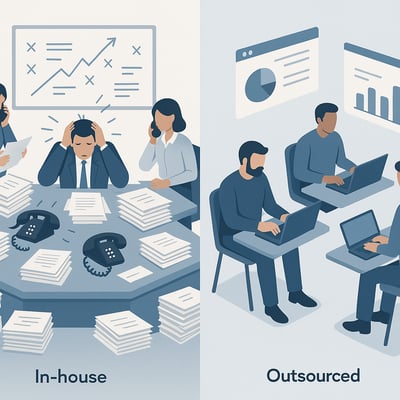Why Aligning Sales & Marketing BDR Teams Boosts Pipeline Growth
Too many B2B orgs lose pipeline momentum because BDRs chase the wrong leads, and marketing campaigns lack sales support. If your teams aren’t synced,...
%20(23).png?width=302&height=302&name=_SD%20web%20assets%202025%20(500%20x%20500%20px)%20(23).png)
6 min read
Eric Smith
:
Aug 16, 2025 8:48:34 AM
Building a consistent pipeline has never been more complex. Marketing and sales leaders are under pressure to fill funnels, drive revenue, and increase efficiency—all without overwhelming their internal teams.
Hiring SDRs and BDRs in-house may seem like the obvious solution. But ramp times are long, recruiting is competitive, and training can stretch already thin resources. Outsourcing these functions presents a smarter, more agile alternative.
SDR and BDR outsourcing isn't just about cost savings. It’s about speed, scalability, and predictability. Done right, it allows you to expand reach, increase meeting volume, and qualify leads at a higher rate—all without adding headcount.
This guide walks through everything you need to know to implement a high-performing outsourced SDR/BDR program—from fundamentals to KPIs to launching a pilot that actually proves ROI.
At first glance, SDRs and BDRs seem interchangeable. But understanding the distinction is critical to building an effective revenue engine.
Sales Development Representatives (SDRs) typically focus on inbound leads. These are contacts who have shown some interest—downloaded content, attended a webinar, or requested a demo. The SDR’s job is to qualify that interest and book meetings with sales.
Business Development Representatives (BDRs) handle outbound prospecting. They identify ideal customers, craft personalized outreach, and open doors that would otherwise stay shut. They're hunters, working in lockstep with your marketing and sales teams to find new business opportunities.
While their approaches differ, both roles are responsible for converting attention into action—specifically, scheduled meetings and qualified pipeline. They sit at the top of your funnel, acting as the front line for brand experience and engagement.
This stage is too important to leave to chance—or overload your AEs with.
There’s a natural resistance to outsourcing something as core as sales development.
But the reality is, outsourcing doesn’t mean giving up control—it means accelerating execution. According to a HubSpot-backed study, over 38% of B2B SaaS companies now outsource part or all of their SDR operations, citing faster ramp times and reduced CAC as key benefits.

Hiring in-house takes time. Beyond sourcing and interviews, reps need to be trained, managed, and coached. That ramp process can easily stretch beyond 90 days before you see meaningful output.
Outsourced teams are different. They come trained, supported by proven playbooks, and ready to start delivering from week one. You're not starting from scratch; you're plugging into a working system.
More importantly, outsourced reps don’t come with long-term overhead. You can scale up quickly for a new product launch or territory test. You can pause programs or shift direction without worrying about restructuring your org chart.
And perhaps most compelling: outsourcing gives you access to specialized expertise. These teams live and breathe outreach. They’ve tested thousands of messages, mastered objection handling, and refined processes that most in-house teams spend years trying to develop.
Speed is the first gain. With outsourcing, your reps are ready faster—sometimes within days. But it doesn’t stop there.
You also unlock efficiency. Every lead is worked quickly, no inquiry goes stale, and sequences are optimized for response.
Quality improves, too. With the right partner, messaging is tightly aligned to your ICP, sequences are tested and refined, and calls are structured to uncover intent early. You get better meetings, not just more of them.
And finally—scalability. Whether you’re exploring new verticals or expanding internationally, outsourcing gives you the flexibility to scale efforts up or down without red tape.
That agility becomes a competitive edge when timelines are tight and targets are ambitious. One study found that companies outsourcing SDRs can achieve up to a 40% reduction in CAC, with ramp times dropping to just 1–2 weeks compared to months for in-house hires.
An outsourced team should never feel like a bolt-on. The goal is integration. That starts with clarity—on goals, on messaging, and on ownership.
Begin by sharing your Ideal Customer Profile (ICP). This includes firmographic and demographic traits, but also pain points, buying triggers, and real-world examples of great-fit accounts. The more context you give, the better the output you’ll get.
Next, align on messaging. Whether you're targeting CFOs in SaaS or IT directors in manufacturing, tone and relevance matter. Your outsourced team should sound like an extension of your brand, not a third-party call center.
Campaign integration is equally important. If your marketing team is promoting a new ebook or hosting a live event, your SDR/BDR outreach should reinforce that message—not compete with it.
Finally, include your sales leaders. Share calendars, dashboards, and feedback loops. Give AEs visibility into who’s being targeted and what messaging is being used. When marketing, sales, and your outsourced team operate from the same playbook, outcomes improve dramatically.
One of the biggest fears about outsourcing is losing control of your brand voice. But in practice, the best outsourced teams are collaborative—not autonomous.
Start by approving messaging frameworks before launch. Review email templates, call scripts, and value props. Then test them in a controlled environment before rolling out at scale.
Set up regular syncs—weekly or bi-weekly—to review performance. Look at call recordings, read replies, and analyze open rates. These sessions aren’t just for troubleshooting—they’re opportunities to fine-tune based on real-world feedback.
Give your outsourced team access to your CRM dashboards. This transparency helps everyone stay aligned on results, and it builds trust that the program is driving pipeline—not just activity.
Control isn’t about doing everything yourself. It’s about building processes that give you visibility, consistency, and the ability to course-correct quickly.
Technology makes or breaks outsourced SDR/BDR programs.
![]() At minimum, your partner needs access to your CRM—whether that’s Salesforce, HubSpot, or another platform. That’s where lead tracking, activity logging, and reporting happen. Without CRM access, reps are flying blind—and you’re left guessing on ROI.
At minimum, your partner needs access to your CRM—whether that’s Salesforce, HubSpot, or another platform. That’s where lead tracking, activity logging, and reporting happen. Without CRM access, reps are flying blind—and you’re left guessing on ROI.
Sales engagement platforms like Outreach, Salesloft, or Apollo are also essential. They allow reps to create and manage cadences, personalize outreach, and report on touchpoint performance.
Call intelligence platforms like Gong or Chorus add another layer. They let you monitor quality, coach in real-time, and ensure that messaging is staying on point.
And finally, make sure your systems talk to each other. If a lead replies to an email, books a meeting, or downloads an asset, those actions should be logged and visible across your stack. Alignment isn’t just strategic—it’s operational.
It’s easy to get caught up in activity metrics—calls made, emails sent, meetings booked. But true success comes down to pipeline contribution.
You’ll want to track:
How many meetings convert to opportunities
How much pipeline is sourced vs. influenced
The average deal size and velocity for outsourced-sourced leads
Activity is a leading indicator. Conversion is the proof.
Compare outsourced performance against your internal benchmarks. Are outsourced reps booking more meetings? Are those meetings converting at similar or better rates?
Use this data to adjust. Maybe one message is outperforming others. Maybe a segment isn’t converting. This is where feedback loops matter most.
What gets measured gets managed. And in outsourced programs, what gets managed drives pipeline.
 Before you scale a program, test it.
Before you scale a program, test it.
A 90-day pilot is usually enough to validate whether an outsourced SDR/BDR strategy will work for your business.
Start with one vertical or one territory. Choose a clearly defined ICP. Agree on goals—such as 20 meetings booked or $200k in qualified pipeline.
Then give your partner space to operate. Review performance weekly, but don’t judge after five days. You need time to calibrate, optimize, and let results compound.
At the end of the 90 days, evaluate. Are the meetings quality? Is sales happy? Is pipeline progressing?
If yes, scale up with confidence. If no, use the learnings to refine. A pilot isn’t just a test of execution—it’s a test of alignment. And alignment is what drives long-term success.
Outsourcing isn’t just about lead volume. It impacts every stage of your funnel.
At the top, you generate more opportunities. More outreach means more conversations. More conversations mean more meetings.
In the middle, you create momentum. Better-qualified leads move faster through sales. AEs waste less time on unqualified calls. Pipeline velocity improves.
Downstream, forecasting gets easier. With a consistent top-of-funnel engine, you can plan accurately, allocate resources better, and build models you can actually trust. Deloitte data cited by MarketStar shows outsourced sales teams can generate ROI as high as 13:1, turning every dollar spent into $13 of revenue.
This is what a full-funnel strategy looks like. It’s not about patching a hole at the top. It’s about building a system that supports revenue from first touch to closed deal.
Outsourcing SDR and BDR functions isn’t a shortcut. It’s a strategy.
It’s how smart teams scale without stretching. How marketing leaders create more lift from existing campaigns. And how sales leaders get more qualified meetings without increasing headcount.
When aligned properly, outsourced teams deliver not just leads—but real pipeline, real insights, and real outcomes.
Start with a pilot. Measure what matters. Optimize constantly. And when the model proves itself, scale it with confidence.
Explore our outsourced BDR services to learn how SmithDigital helps revenue teams unlock growth at scale.
📘 Download the SDR/BDR Outsourcing Playbook
Get the frameworks, scripts, and dashboards leading GTM teams use to turn outsourced effort into measurable pipeline.

Too many B2B orgs lose pipeline momentum because BDRs chase the wrong leads, and marketing campaigns lack sales support. If your teams aren’t synced,...
What’s the most effective way for a B2B company to attract high-quality leads and fuel long-term growth?

6 min read
Your website is the centerpiece of your marketing engine. For business owners and marketing managers using HubSpot, it’s not just about having...